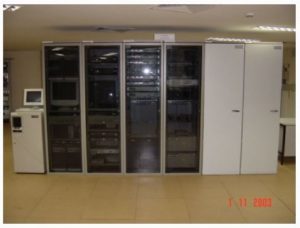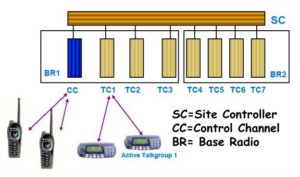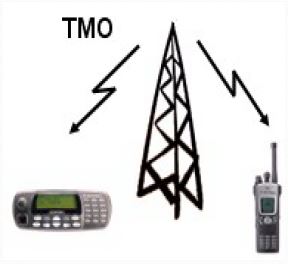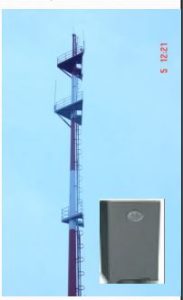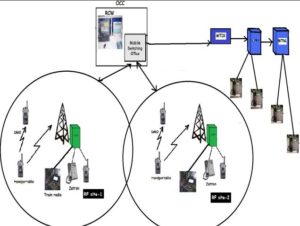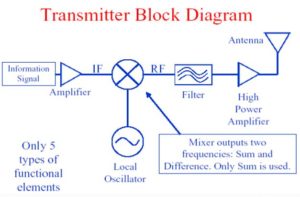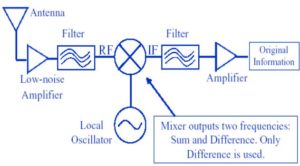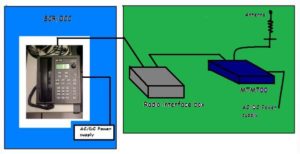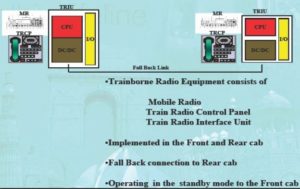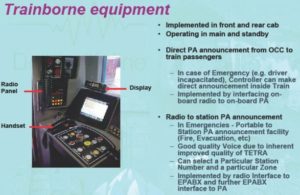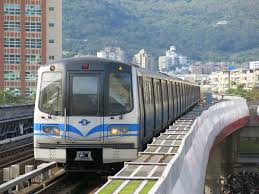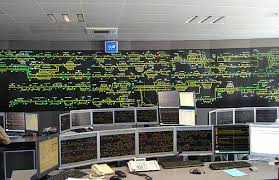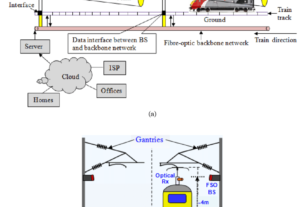Metro Rail Communication Through Radio Systems
Radio Waves
A radio uses electromagnetic waves to send information across the air. This is accomplished by producing an electrical signal that moves back and forth, or oscillates, at a rapid rate.
Technology in use:
1. Terrestrial Trunked Radio (TETRA) (formerly known as Trans European Trunked Radio) is a specialist professional Mobile Radio and two-way transceiver specification.
2. This standard was developed by the ETSI for private mobile radio. Open standard for private mobile radio. It defines radio services and interfaces
3. The TETRA standard defines the air interface between mobile stations and the infrastructure.
Radio system
1. The Radio system is a digital trunked radio system, operating in 380-400 MHz band and confirming TETRA standards.
2. The Radio system has central control equipment installed in OCC.
3. The Radio system uses EBTS towers for communication in the rail corridor & leaky coaxial cable along each track in the tunnels for communication with train-borne mobile radio (in the metro corridor).
Metro Rail Communication Through Radio Systems – RADIO CENTRAL EQUIPMENT AT OCC
Trunking
The trunking concept allows channels or other resources to be made available to users as they are needed. It allows all the channels to be pooled together. As a channel is needed, the controller grants an available channel from its pool of channels.
TETRA Trunking
Talk group
1. In most organizations, radio users work in groups that are based on their functions and responsibilities. These groups of radio users can be assigned to communication talk groups that reflect their function or responsibilities.
Calls are semi-duplex.
TYPES OF MODES OF COMMUNICATION:
1. Trunk Mode Operation: It represents communication between two or more TETRA mobile stations with the use of trunking network infrastructure.
This model consists of 4 communication modes:
(a) Group mode (b) Private mode
(c) Phone mode (d) Emergency mode
(a) Group Mode:
It is a half-duplex communication mode in which many users can communicate with each other by selecting a common talk group.
(b) Private Mode:
It is a half as well as full-duplex communication mode in which many users can communicate with each other privately without interfering with the talk group. It uses two frequencies.
(c) Phone Mode:
It is a full-duplex mode of communication in which a radio user can talk to any dialed phone number within Metro or external network connected to the metro.
(d) Emergency Call:
The emergency key is provided on every piece of radio equipment, and the audiovisual alarm will appear on every radio unit in that talk group. The party who initiates the call has the highest priority for calling.
2. Direct Mode Operation:
It represents direct communication between two or more TETRA mobile stations without the use of trunking network infrastructure.
Simplex mode of communication.
EBTS (Enhanced base Transreceiver System)
• It provides an RF interface from the master site to the mobile subscribers in a TETRA system. It can be categorized into two configurations:
(a) Above ground (Rail corridor)
(b) Underground (Metro corridor)
•Both are of the same configuration & characteristics.
OCC
Transmitter
1. A transmitter transmits a radio signal.
2. A transmitter usually has a power supply, an oscillator, a modulator, and amplifiers.
Receiver
1. A receiver is a device that receives a radio signal from an antenna and decodes the signal for use
2. Generally, receiver refers to a demodulator, a preamplifier, and a power amplifier
Receiver Block Diagram
Types of radio
1. Mobile Vehicle radio\Fixed
(a) RAU (Radio Access Unit) or Zetron radio set or Station radio
(b) Train radio set
(c) RCW (Radio console workstation)
2. Mobile Portable radio
Each radio has its radio identification which registers itself in the central system for its function. The radio is programmed for its ID, frequency, network code, talk group, and allowing types of call. Radio consists of trans and receiver and frequency synthesizer circuit which function along with DSP (Digital Signal Processor) for digital function.
RAU(Radio Access Unit)
1. It is located in the Station control room.
2. It is placed in the best radio coverage and it is fixed & has a functionality just like a telephone radio.
3. It is ideally suited to radio operator dispatchers and where office personnel needs access to a radio system without wanting to have a radio placed into the office environment.
4. The M390 is a robust telephone-style desktop controller with a large, easy-to-read LCD display & handset.
Train radio
1. MTM700 Mobile radio is installed at front & rear cab for communication between the train driver & designated station controllers at OCC & Depots.
2. This radio unit is connected to different units e.g. TRIU, TRCP; these units are required to communicate with RCW, TIMS, ATS, and rear cab radio.
3. Dome-type omnidirectional antenna is located at the top roof of the train. This antenna is connected through an RF cable which is connected to a radio unit.
Front and rear view of Train radio in the cab
Trainborne equipment
Radio console workstation
1. It is for different controllers that are working in OCC such that chief and traffic controllers, etc.
2. On its MMI, all the radio information is displayed and communication can be set up only by clicking the radio identity.
Hand Portable radio
The hand portables come with 3×4 keypads, rotary switch dial, and LCD for number dialing and maximum flexibility. Each hand portable is equipped with ultra high capacity batteries (Li-ion or Li Mgh.) for longest standby and talk-time of 24 hrs, that is 5% transmit, 5% Receive, and 90% standby.
Hand portable is suitable for all kinds of calls used in DMRC.
Advantages of TETRA:
1. The frequency used gives a longer range, which permits high levels of geographic coverage with a smaller number of transmitters, thus cutting infrastructure costs.
2. Unlike cellular technologies, TETRA is built to do one-to-one, one-to-many and many-to-many.
3. Rapid deployment (transportable) network solutions are available for disaster relief and temporary capacity provision.
4. In the absence of a network mobiles/portables can use ‘direct mode’ whereby they share channels directly (walkie-talkie mode).
Disadvantages of TETRA:
1. Requires a linear amplifier to meet the stringent RF specifications that allow it to exist alongside other radio services.
2. Handsets are more expensive than cellular.
3. Handsets can sometimes interfere with badly designed (usually old) or sensitive electronic devices such as broadcast (TV) receivers, hospital equipment, speed cameras.
Conclusion:
1. TETRA communication system has been implemented successfully
2. The signals are clear
3. The voice clarity is excellent
4. The TETRA technology effectively meets DMRC’s operational and functional expectations
For More Information:- https://www.ltmetro.in/hyderabad-metro-rail/project-highlights/telecom-system/


